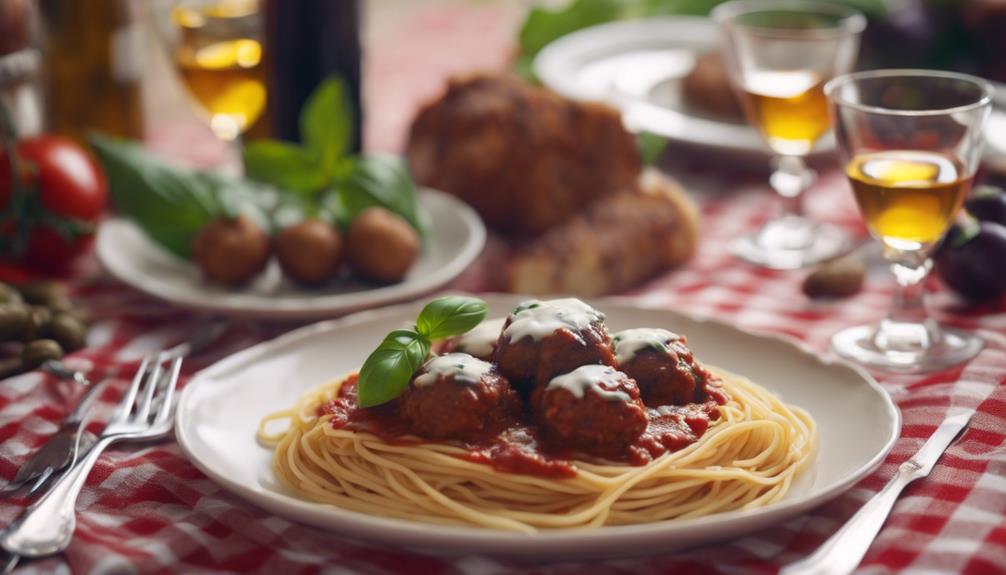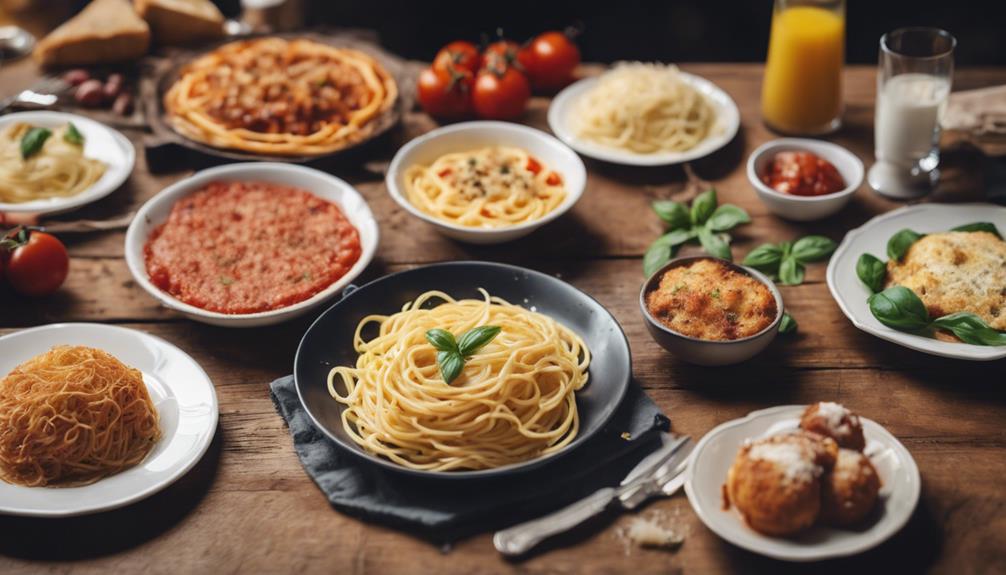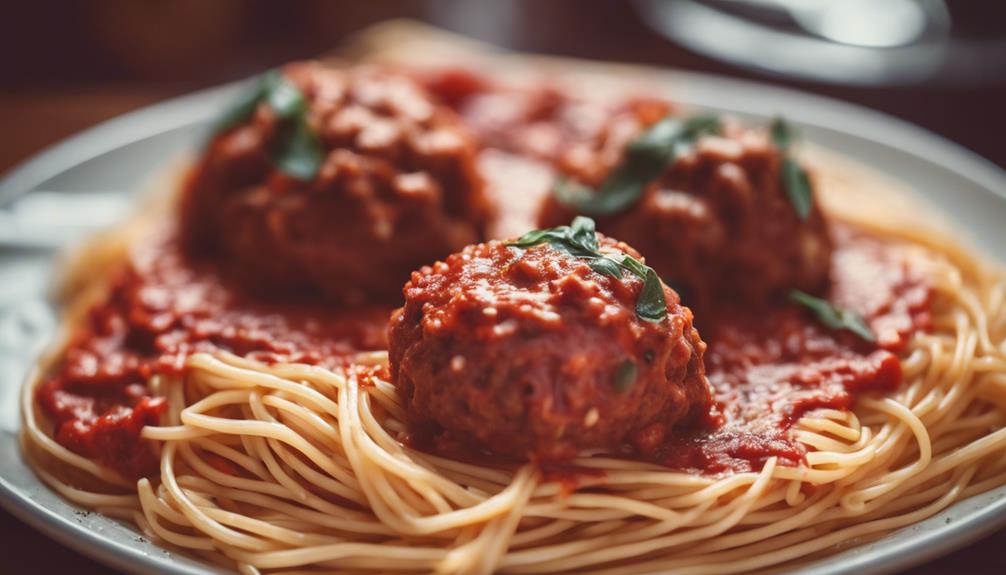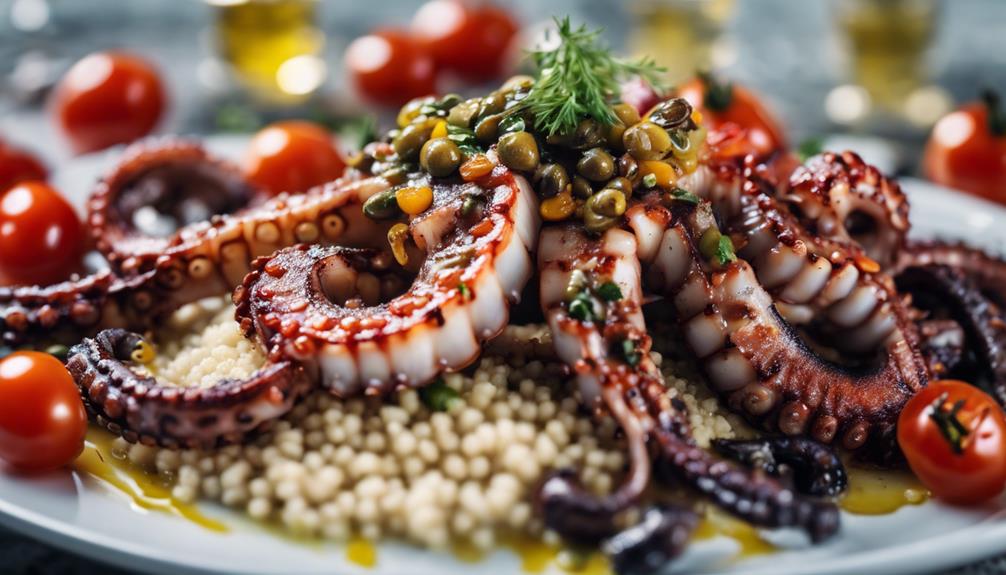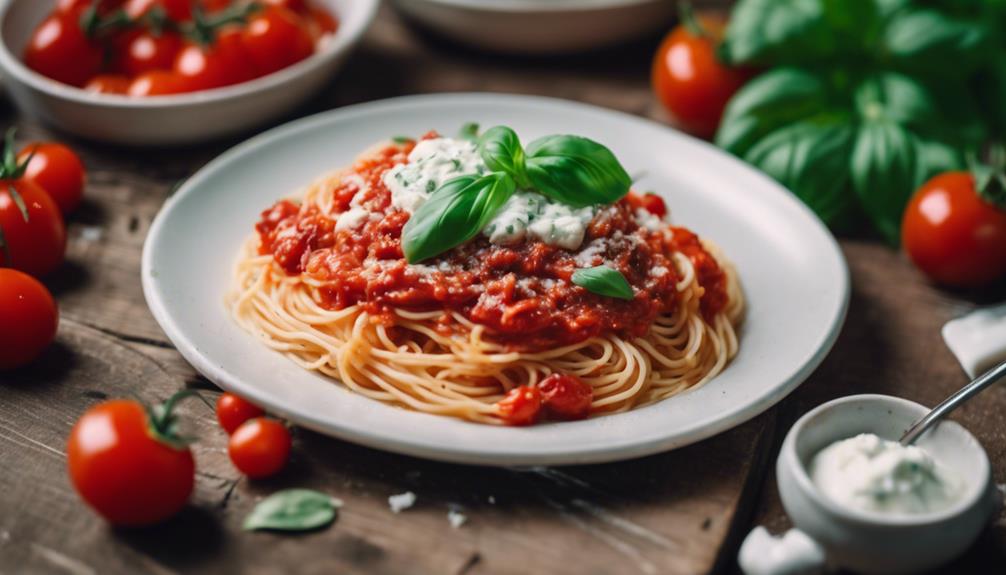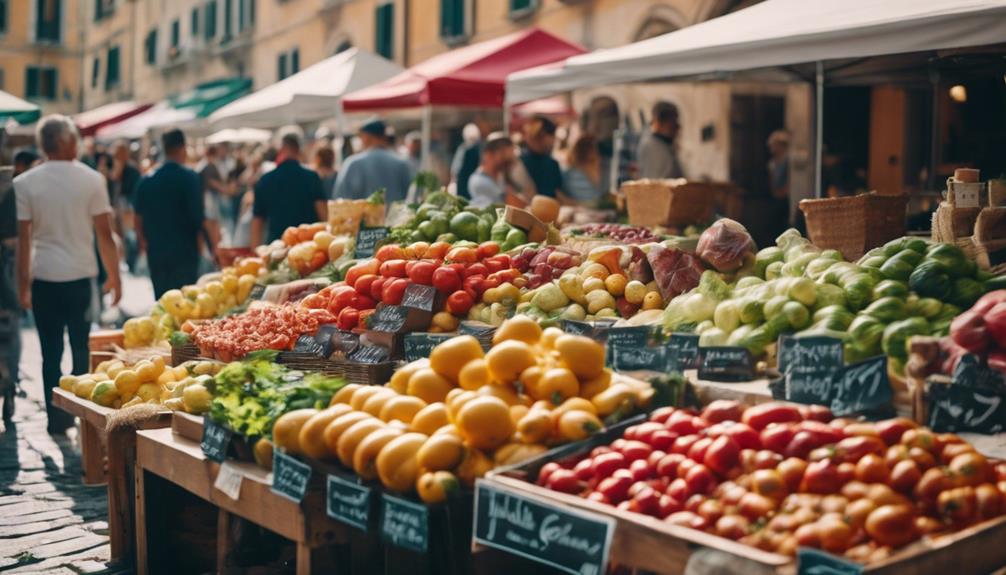Embark on a flavorful adventure through Italian American cuisine. The combination of classic Italian recipes with American influences has resulted in a diverse array of dishes, representing a cherished culinary legacy. Delve into the mix of southern Italian essentials with northern Italian nuances. Indulge in Spaghetti and Meatballs and Chicken Parmesan, showcasing the fusion of Italian and American tastes. Savor the delicious Italian American desserts such as Tiramisu and Cannoli. From savory soups to iconic meat and chicken entrees, each bite embodies a special fusion of culinary customs. The lively flavors of Italian American cuisine are ready for you to explore.
Key Takeaways
- Italian American cuisine blends traditional Italian recipes with American influences.
- Fusion of flavors creates a rich tapestry of unique dishes.
- Bold use of garlic, olive oil, and tomatoes highlights culinary influences.
- Iconic dishes like Spaghetti and Meatballs symbolize the blend of Italian and American flavors.
- Regional American influences enrich classic Italian dishes.
Historical Roots of Italian American Cuisine
Italian American Cuisine has deep historical roots that trace back to the culinary traditions of Italian immigrants who settled in the US during the late 19th and early 20th centuries. These immigrants brought with them a rich tapestry of culinary traditions, including the iconic tomato sauce that's synonymous with Italian American cuisine today.
The history of Italian American communities is intertwined with the development of this cuisine, as these immigrants adapted their traditional dishes to suit the ingredients available in their new homeland.
The culinary traditions of these Italian immigrants laid the foundation for what would become a unique blend of southern Italian staples and northern Italian influences. The exchange of regional recipes among Italian immigrants played an important role in shaping the evolution of Italian American cuisine, resulting in a fusion of flavors that continues to delight palates across the country.
The history of Italian American cuisine is a reflection of the resilience and creativity of immigrant communities aiming to preserve their cultural heritage through food.
Fusion of Flavors in Italian American Dishes
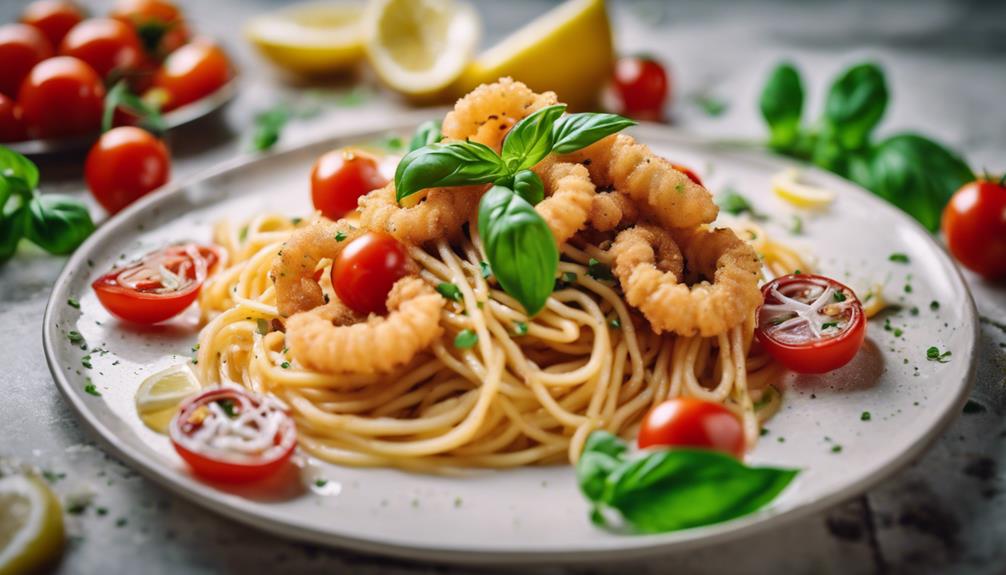
Italian American dishes are known for their unique fusion of flavors, blending traditional Italian ingredients with American culinary influences.
This combination results in dishes that are both comforting and robust, such as Chicken Parmesan and Shrimp Scampi.
The marriage of old-world Italian recipes with new-world ingredients creates a rich tapestry of flavors in Italian American cuisine.
Flavorful Culinary Combinations
In Italian American cuisine, the fusion of flavors creates unique and mouthwatering culinary combinations. The blending of American comfort food staples with traditional Italian ingredients has led to the creation of iconic dishes like Spaghetti and Meatballs. This dish symbolizes the fusion of Italian meatballs with American-style pasta, resulting in a flavorful and satisfying meal.
Another beloved dish in American Italian cuisine is Chicken Parmesan, known as Chicken Parm. This quintessential Italian American dish features breaded chicken cutlets topped with tomato sauce and melted cheese, offering a delicious mix of flavors and textures.
The fusion of southern and northern Italian culinary traditions by Italian immigrants has played a significant role in shaping Italian American cuisine. The exchange of regional recipes among immigrants and the influence of both Italian and American culinary traditions have contributed to the development of unique and flavorful culinary combinations that continue to delight palates across the United States.
Traditional Meets Modern
Embracing a fusion of traditional and modern flavors, Italian American dishes offer a tantalizing culinary experience that blends the best of both worlds. This unique cuisine combines the time-honored recipes of Italy with the contemporary palate of America, resulting in a diverse array of dishes that satisfy a range of tastes.
Classic Italian dishes like Chicken Parmesan and Spaghetti and Meatballs have been transformed by incorporating American ingredients and cooking techniques, creating a harmonious blend of flavors that captivate diners.
The bold use of ingredients such as garlic, olive oil, and tomatoes in Italian American cuisine highlights the influence of both Italian and American culinary traditions. These flavors not only pay homage to the roots of Italian cooking but also reflect the evolution of these traditional recipes to suit the American taste buds.
The infusion of regional American influences into classic Italian dishes is a defining characteristic of Italian American cuisine, offering a rich and flavorful dining experience that continues to evolve with each generation.
New World Influences
Drawing upon a blend of southern and northern Italian culinary traditions, the fusion of flavors in Italian American dishes creates a unique and diverse gastronomic experience.
Italian American cuisine reflects a harmonious integration of ingredients like dry pasta, tomato sauce, and olive oil from southern Italy, combined with staples from northern regions such as white sauce and polenta.
Unlike traditional Italian peasant cuisine, Italian American dishes tend to emphasize richer ingredients, showcasing a departure from the simplicity of their origins.
The exchange of regional recipes among Italian immigrants further contributed to the evolution of Italian American cuisine, enriching it with a variety of flavors and techniques.
Importantly, northern Italian influences, particularly from cheesemakers, played a significant role in shaping the culinary landscape of Italian American dishes.
This amalgamation of southern and northern Italian elements has resulted in a culinary tradition that isn't only deeply rooted in heritage but also continuously evolving to embrace new influences in the New World.
Popular Italian American Pasta Creations
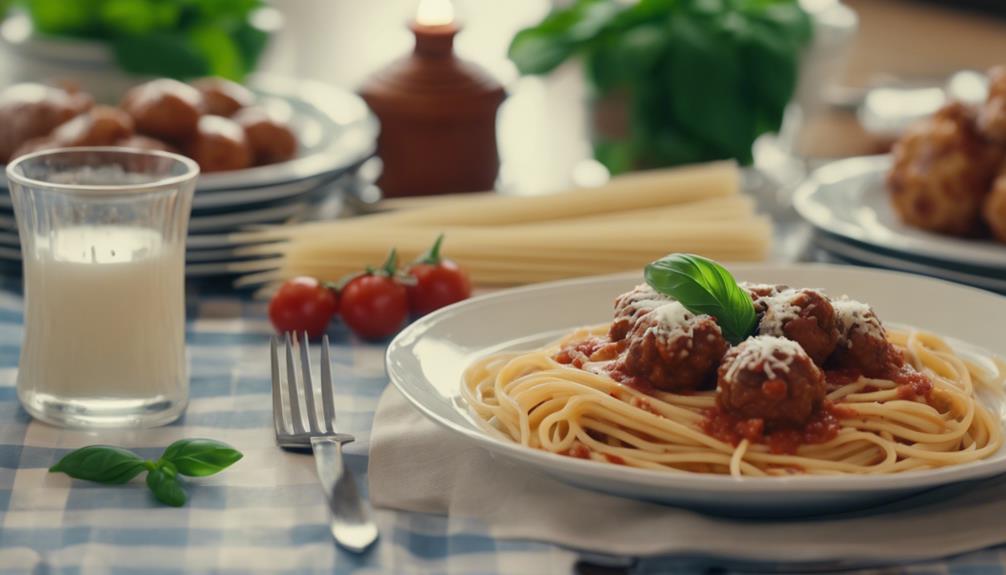
Italian American pasta creations are a beloved part of the culinary landscape, offering a diverse array of classic dishes and regional specialties.
From the timeless Spaghetti and Meatballs to rich Fettuccine Alfredo, these pasta dishes showcase the fusion of Italian and American flavors.
Whether you're craving seafood options like Shrimp Scampi or indulging in a hearty plate of Angel Hair Pasta, Italian American cuisine has a pasta creation to satisfy every palate.
Classic Pasta Dishes
Among the popular Italian American pasta creations, you'll find classic dishes like Spaghetti and Meatballs, Fettuccine Alfredo, and Chicken/Veal Parmigiana. These dishes are staples in Italian American cuisine, blending traditional Italian pasta recipes with American influences to create flavorful and comforting meals. The table below provides a quick overview of these beloved classics:
| Dish | Description |
|---|---|
| Spaghetti and Meatballs | A symbol of family gatherings, this dish features spaghetti topped with savory meatballs in a rich tomato sauce. |
| Fettuccine Alfredo | Known for its creamy and indulgent sauce, Fettuccine Alfredo is a decadent pasta dish made with butter, cream, and Parmesan cheese. |
| Chicken/Veal Parmigiana | Breaded and fried chicken or veal cutlets smothered in tomato sauce and melted cheese, Chicken/Veal Parmigiana is a favorite comfort food among Italian American communities. |
Regional Pasta Specialties
Featuring a diverse array of pasta dishes that reflect regional influences, Italian American cuisine showcases a rich tapestry of flavors and culinary traditions. Regional pasta specialties play a significant role in the fusion of Italian and American culinary traditions.
Classic pasta dishes like Spaghetti and Meatballs have been popularized in Italian American communities, becoming iconic representations of this cuisine. Staples such as Fettuccine Alfredo and Capellini exemplify the harmonious blend of Italian flavors like garlic, olive oil, and tomato sauce with American preferences.
Italian American cuisine embraces comfort foods like Angel Hair Pasta, beloved for their simplicity and heartiness. These regional pasta specialties have evolved over time, with regional American variations of traditional Italian pasta dishes making their mark in Italian American cooking.
The result is a vibrant and flavorful culinary landscape that continues to celebrate the heritage and creativity of Italian American communities through their pasta creations.
Iconic Meat and Chicken Dishes
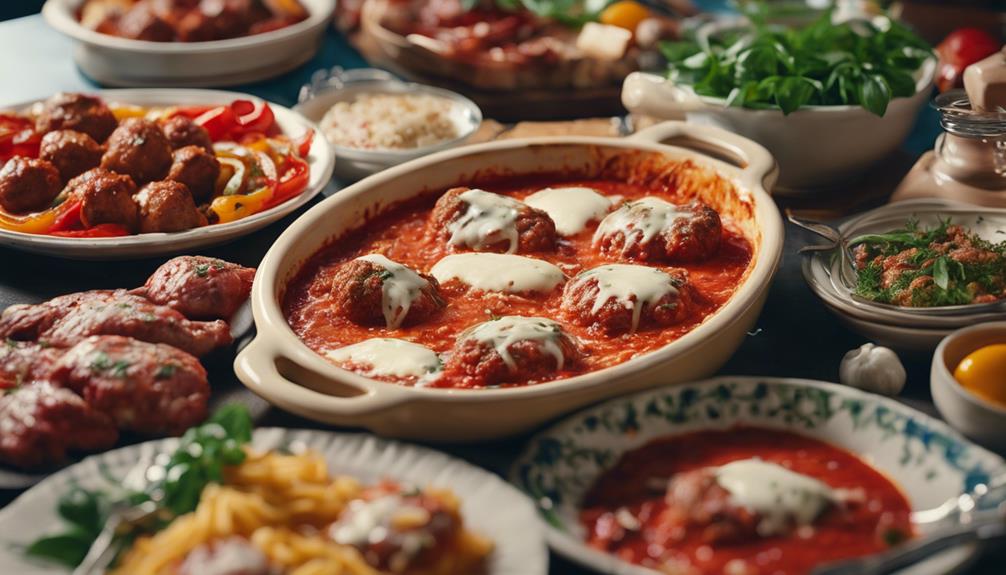
When exploring iconic meat and chicken dishes in Italian American cuisine, one can't overlook the beloved Spaghetti and Meatballs. This classic comfort food combines spaghetti, meatballs, and tomato sauce, embodying the heartiness and bold flavors typical of Italian American dishes.
Another popular choice is Chicken Parmesan, known affectionately as Chicken Parm, featuring breaded chicken cutlets smothered in tomato sauce and melted cheese, a delicious fusion of Italian and American culinary influences. Garlic, olive oil, and cheese are staples in these dishes, adding depth and richness to the flavors.
Italian American cuisine emphasizes family-style dining experiences, with meatballs, Chicken Parmesan, and seafood dishes like Shrimp Scampi and Lobster Fra Diavolo playing integral roles. These dishes symbolize the fusion of Italian and American traditions, offering a taste of both worlds in every savory bite.
Whether enjoyed in restaurants or homemade in kitchens across the country, these iconic meat and chicken dishes continue to hold a special place in the hearts and stomachs of many.
Delightful Italian American Desserts

Italian American desserts offer a delightful fusion of traditional Italian flavors with American influences, creating a rich and diverse array of sweet treats to satisfy any palate.
Among the most iconic Italian American desserts is Tiramisu, a luscious dessert made of layers of coffee-soaked ladyfingers and creamy mascarpone cheese, dusted with cocoa powder.
Cannoli, another beloved classic, consists of crispy fried pastry tubes filled with sweet ricotta cheese and often studded with chocolate chips or candied fruits.
Gelato, the Italian cousin of ice cream, has found a special place in Italian American cuisine with its dense, velvety texture and intense flavors ranging from pistachio to stracciatella.
Italian American dessert tables often feature Zeppole, a fried dough treat dusted with powdered sugar, commonly enjoyed during festive celebrations.
Amaretto cookies, made with almond paste and flavored with Amaretto liqueur, offer a sweet and nutty indulgence.
Italian American bakeries are also revered for their Sfogliatelle, a flaky pastry filled with sweet ricotta cheese, showcasing the skill and craftsmanship of Italian American bakers.
The Influence of Italian American Wine
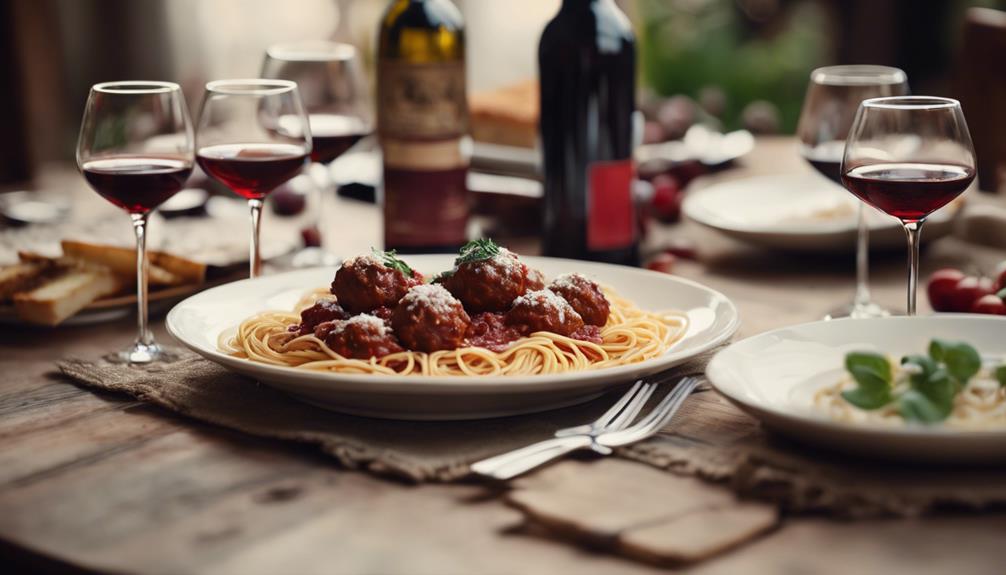
With roots dating back to the late 18th century, the influence of Italian American wine production is a rich and integral part of the US wine industry. Italian American winemakers have made significant contributions to American viticulture, shaping the landscape of wine in the country.
Here are some key points highlighting the impact of Italian American wine:
- Historical Legacy: Italian immigrants planted vineyards in California, laying the foundation for the thriving wine industry we see today.
- Renowned Wineries: Several iconic wineries established by Italian immigrants have become synonymous with quality and tradition in American winemaking.
- Innovative Techniques: Italian American winemaking techniques have influenced the American wine scene, introducing grape varietals like Zinfandel and Barbera to widespread popularity.
- Cultural Fusion: Italian American winemakers blend traditional Italian winemaking practices with American tastes and terroir, creating a unique and diverse range of high-quality wines.
The legacy of Italian American winemaking continues to evolve, showcasing a blend of heritage and innovation that resonates throughout the US wine industry.
Savory Soups and Stews in Italian American Cooking

To conclude, the culinary landscape of Italian American cuisine expands to include a delectable array of savory soups and stews that embody a fusion of flavors and traditions. Italian American cuisine features a variety of hearty soups and stews that have become staples in households and restaurants across the United States.
Cioppino, a seafood stew originating from San Francisco's Italian immigrant community, showcases a delightful mix of fresh seafood simmered in a savory tomato broth. Wedding soup, a traditional Italian American dish, combines flavorful meatballs, greens, and pasta in a comforting broth.
Pasta e fagioli, a hearty soup blending pasta and beans in a rich tomato base, provides a satisfying meal option. For those seeking a vegetable-packed option, minestrone, a popular Italian American vegetable soup, offers a medley of seasonal vegetables in a flavorful broth. Finally, stracciatella, an Italian American egg drop soup, combines the simplicity of broth, eggs, and Parmesan cheese for a warm and comforting dish.
Breads and Baked Goods in Italian American Cuisine
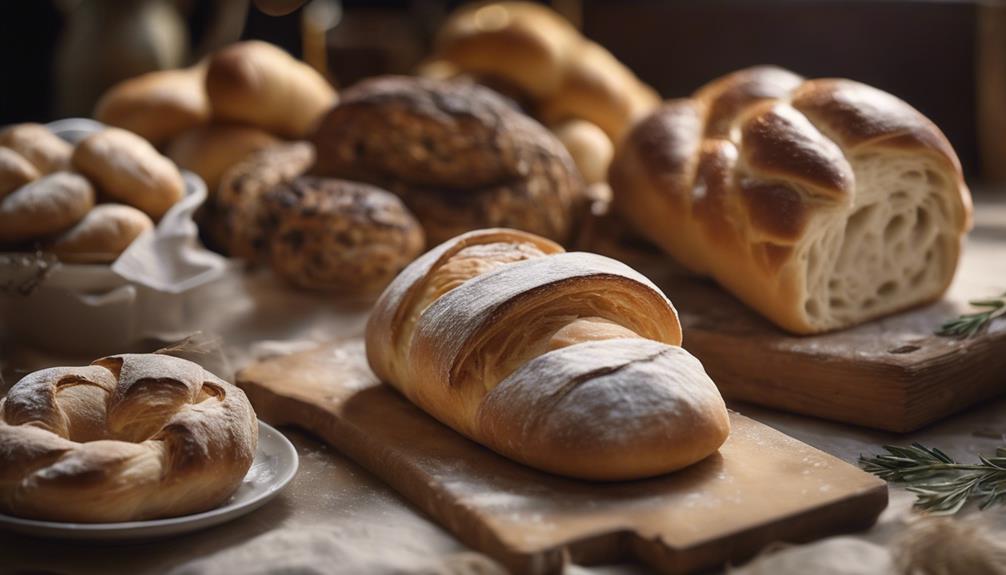
Explore the delightful array of breads and baked goods that play a prominent role in the culinary tapestry of Italian American cuisine.
- Italian Bread: A classic staple in Italian American cuisine, Italian bread is known for its crusty exterior and soft interior, perfect for dipping into sauces or creating sandwiches.
- Calzone: A folded pizza dough filled with a variety of ingredients such as cheese, meats, and vegetables, baked to golden perfection.
- Stromboli: Similar to a calzone but rolled instead of folded, stromboli is a savory baked turnover filled with Italian meats, cheeses, and vegetables.
- Pizza: While originating in Italy, pizza has evolved in the United States to include various styles like New York-style pizza, showcasing a thin crust topped with tomato sauce, cheese, and a variety of toppings.
These bread-based dishes blend traditional Italian baking techniques with American influences, creating a unique fusion of flavors that has become a hallmark of Italian American cuisine.
Exploring Seafood Offerings in Italian American Menus
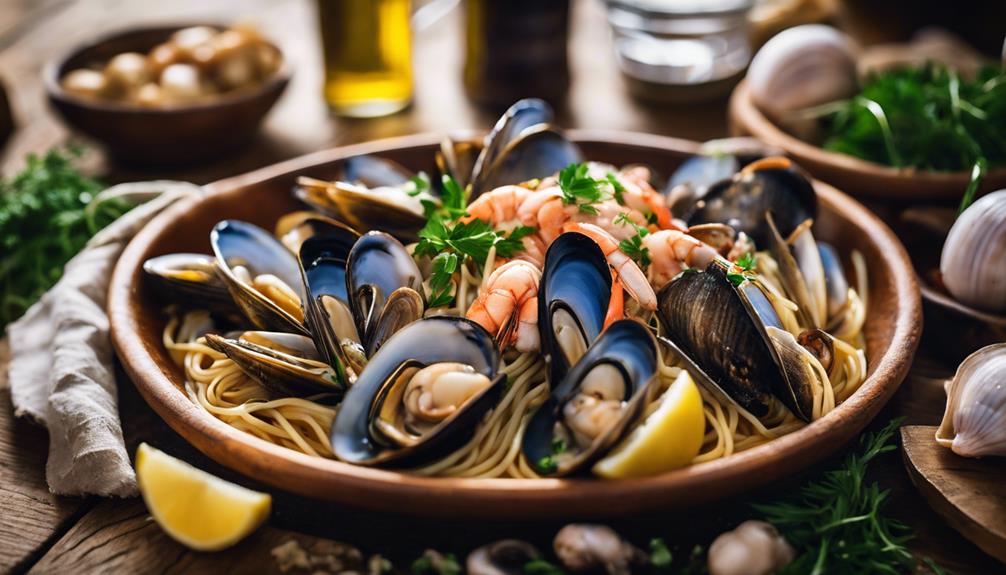
Curious about the diverse seafood offerings on Italian American menus? Italian American cuisine boasts a rich variety of seafood dishes that blend culinary influences from both Italy and the United States. From classic favorites like Shrimp Scampi and Lobster Fra Diavolo to regional specialties such as Maryland Crab Cakes, these menus cater to a wide range of tastes. Popular choices like Cioppino and Alici acciughe exemplify the diversity found in Italian American seafood offerings.
Italian American restaurants often feature traditional seafood soups like Zuppa di Pesce and Clam Chowder, adding depth and flavor to their menus. The fusion of Italian cooking techniques with American ingredients has led to the creation of unique dishes that have become staples in Italian American cuisine.
Whether you're a fan of the classics or excited to explore new flavors, seafood dishes in Italian American menus offer a delightful culinary experience that celebrates the best of both worlds.
Frequently Asked Questions
What Flavours Are in Italian Cuisine?
Italian cuisine features bold flavors such as garlic, olive oil, tomatoes, and cheese. Staples like pasta, pizza, tomato sauce, and fresh herbs are common. A mixture of American regional influences shapes Italian American cuisine, offering comfort foods and seafood dishes.
What Is the Flavor Profile of Italian Cuisine?
Imagine a burst of flavors dancing on your taste buds! Italian cuisine tantalizes with robust garlic, olive oil, tomatoes, and cheeses. The flavor profile is a symphony of savory delights, perfect for hearty family feasts.
How Did Italy Influence American Cuisine?
Italy influenced American cuisine through the migration of Italian immigrants, blending traditional Italian ingredients with American techniques. Staples like garlic, olive oil, tomatoes, and cheese are now integral to American dishes, creating beloved comfort foods.
What Defines Italian Cuisine?
Italian cuisine is defined by its simplicity, quality ingredients, and regional diversity. Staples like olive oil, tomatoes, garlic, and fresh herbs shine in dishes. From north to south, Italian food celebrates fresh, seasonal flavors and traditional cooking methods.
How Did Italian Cuisine History Shape Italian American Cuisine Flavors?
The evolution of Italian cuisine has greatly influenced Italian American cuisine flavors. The introduction of new ingredients and cooking techniques in America has resulted in a fusion of traditional Italian dishes with local flavors. This blend has created unique and diverse Italian American cuisine offerings that reflect the evolution of Italian cuisine.
Conclusion
To conclude, Italian American cuisine offers a tantalizing tapestry of tastes that excite the taste buds. From pasta to poultry, wine to seafood, this culinary tradition blends the best of both worlds.
So, next time you dine out, don't hesitate to explore the delectable dishes that define Italian American fare. Embrace the essence of Italy in every bite and savor the symphony of flavors that sing in your mouth.
Bon appétit!
